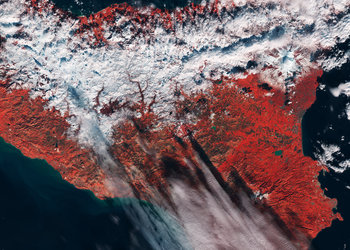Accept all cookies Accept only essential cookies See our Cookie Notice

About ESA
The European Space Agency (ESA) is Europe’s gateway to space. Its mission is to shape the development of Europe’s space capability and ensure that investment in space continues to deliver benefits to the citizens of Europe and the world.
Highlights
ESA - United space in Europe
This is ESA ESA facts Member States & Cooperating States Funding Director General Top management For Member State Delegations European vision European Space Policy ESA & EU Space Councils Responsibility & Sustainability Annual Report Calendar of meetings Corporate newsEstablishments & sites
ESA Headquarters ESA ESTEC ESA ESOC ESA ESRIN ESA EAC ESA ESAC Europe's Spaceport ESA ESEC ESA ECSAT Brussels Office Washington OfficeWorking with ESA
Business with ESA ESA Commercialisation Gateway Law at ESA Careers Cyber resilience at ESA IT at ESA Newsroom Partnerships Merchandising Licence Education Open Space Innovation Platform Integrity and Reporting Administrative Tribunal Health and SafetyMore about ESA
History ESA Historical Archives Exhibitions Publications Art & Culture ESA Merchandise Kids Diversity ESA Brand Centre ESA ChampionsLatest
Space in Member States
Find out more about space activities in our 23 Member States, and understand how ESA works together with their national agencies, institutions and organisations.
Science & Exploration
Exploring our Solar System and unlocking the secrets of the Universe
Go to topicAstronauts
Missions
Juice Euclid Webb Solar Orbiter BepiColombo Gaia ExoMars Cheops Exoplanet missions More missionsActivities
International Space Station Orion service module Gateway Concordia Caves & Pangaea BenefitsLatest
Space Safety
Protecting life and infrastructure on Earth and in orbit
Go to topicAsteroids
Asteroids and Planetary Defence Asteroid danger explained Flyeye telescope: asteroid detection Hera mission: asteroid deflection Near-Earth Object Coordination CentreSpace junk
About space debris Space debris by the numbers Space Environment Report In space refuelling, refurbishing and removingSafety from space
Clean Space ecodesign Zero Debris Technologies Space for Earth Supporting Sustainable DevelopmentApplications
Using space to benefit citizens and meet future challenges on Earth
Go to topicObserving the Earth
Observing the Earth Future EO Copernicus Meteorology Space for our climate Satellite missionsCommercialisation
ESA Commercialisation Gateway Open Space Innovation Platform Business Incubation ESA Space SolutionsEnabling & Support
Making space accessible and developing the technologies for the future
Go to topicBuilding missions
Space Engineering and Technology Test centre Laboratories Concurrent Design Facility Preparing for the future Shaping the Future Discovery and Preparation Advanced Concepts TeamSpace transportation
Space Transportation Ariane Vega Space Rider Future space transportation Boost! Europe's Spaceport Launches from Europe's Spaceport from 2012Latest

ERS-2 radar view of Strait of Messina, Italy
Thank you for liking
You have already liked this page, you can only like it once!
The Strait of Messina – the narrow section of water separating the Italian Peninsula (seen on the right) from Sicily – is featured in this multi-colour ERS-2 composite image.
Located in the Mediterranean Sea, the Strait joins the Tyrrhenian Sea in the north with the Ionian Sea in the south and has a reputation for its hydrological peculiarities – namely whirlpools, strong currents and internal waves.
Throughout history the Strait has received a lot of attention because of its dangerous waters. In Greek mythology, a six-headed monster named Scylla lived on the Italian Peninsula and would pull sailors up and devour them if they came within her grasp, while an all-consuming whirlpool called Charybdis, on the Sicilian side, would suck passersby to their deaths.
In Homer’s Odyssey, Odysseus and his crew confronted the two monsters while navigating through the Strait. Emphasizing the dangers of the narrow Strait – 32 kilometres long and from 3 to 16 kilometres wide – it was only possible to avoid one of the monsters by sailing closely to the other. Odysseus navigated his ship through safely, but Scylla managed to catch and devour six of his men.
Currently, the Strait is at the centre of a much-debated topic over whether a bridge should be built to connect Sicily to the peninsula. If built, it would be the longest suspension bridge in the world (3.7 kilometres).
Opponents say the bridge will damage the unique ecosystem of the area. According to the World Wide Fund for Nature (WWF), the area around the Strait borders one of the three most important European migration routes for many birds, with some 34,000 birds (comprised of 32 different species) passing through the area in just two months.
The main towns of the Strait are Messina, on the Sicilian side, and Reggio-Calabria on the peninsula side. The two mountain ranges seen in the image are the Monti Peloritani, in Sicily, and the Aspromonte, in Calabria.
Messina and Reggio di Calabria were both founded in the late 8th Century B.C. by the Greeks. Because of their strategic port locations, both cities have suffered numerous foreign invasions. The area was also hit by two major earthquakes in 1783 and 1908; the latter nearly destroyed the entire city of Messina.
The image is composed of three ERS-2 SAR PRI (Precision Radar Image) images acquired on different dates with different colours assigned to each date: red for 13 February 2002; green for 11 August 2004; blue for 5 May 1999.
The image covers a width of 100 kilometres and has a 12.5 metre pixel sampling.
-
CREDIT
ESA -
LICENCE
ESA Standard Licence and Additional permission may be required
(contact spaceinimages@esa.int for further information)

Sicilian snow

Syracuse, Italy

Saharan dust over the Strait of Messina

Favignana, Levanzo and western Sicily















 Germany
Germany
 Austria
Austria
 Belgium
Belgium
 Denmark
Denmark
 Spain
Spain
 Estonia
Estonia
 Finland
Finland
 France
France
 Greece
Greece
 Hungary
Hungary
 Ireland
Ireland
 Italy
Italy
 Luxembourg
Luxembourg
 Norway
Norway
 The Netherlands
The Netherlands
 Poland
Poland
 Portugal
Portugal
 Czechia
Czechia
 Romania
Romania
 United Kingdom
United Kingdom
 Slovenia
Slovenia
 Sweden
Sweden
 Switzerland
Switzerland

























